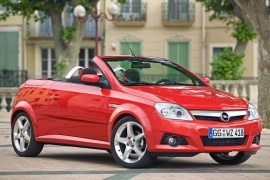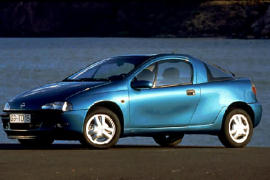OPEL Tigra Models/Series Timeline, Specifications & Photos
First production year: 1994
Engines: Diesel, Gasoline
Body style: Hatchback
Based on the successful model Corsa, the Tigra Twintop was the first, small class coupe-cabriolet for the German car-maker. Its angular look and two-seat only, made it an excellent boulevard-cruiser.
Opel was not very concerned to built convertibles in the past. It tried the market with a city-coupe named Tigra, in 1994 and it stopped the production in 2001 due to poor sales. But the car-maker didn't stop. It tried again in 2004 with a new generation. That time was a coupe-cabriolet vehicle.
The design was inspired by its bigger brother, the Astra, even though it was based on the same platform with the Corsa. The chromed line on the grille the angular lines and clear edges made the car look different on the small-segment category. For the retractable hard-top, Opel employed the same company which made the Peugeot 206 CC, the French coachbuilder Heuliez. In the back, the big taillights were inspired by those found in the Astra.
The 206 installed a bench in the back, which was small even for a toddler. The Tigra Twintop didn't even try to install one. The dashboard design was similar to the Corsa C (the third generation) and so was the center stack and the door panels.
Under the hood, Opel installed a choice of three engines: two gasoline and one turbodiesel. The latter was developed by the Italian car-maker Fiat. All versions were mated to a standard 5-speed manual. An automated, single-clutch, 5-speed gearbox was available as an option.
Opel launched the small Tigra coupe at the 1993 Frankfurt Motor Show, but sales only started one year later. It was the sportier version of the second-generation of the small-class Opel Corsa.
Two gasoline engines were available: a 1.4-liter and a 1.6-liter engine, developing 90 and 106 hp, respectively. For the transmission, only the 1.4-liter was also available with a 4-speed automatic transmission, with the rest coming as standard with a 5-speed manual. The front fog lights were standard on the 1.6-liter, but not available at all for the 1.4-liter.
Performance numbers are modest, with the 1.6-liter version being able to do a 0-100 kph (0-62 mph) sprint in 10.5 seconds, and reaching a top speed of 203 kph (126 mph), due to a very good drag coefficient of 0.31. The big change compared to the regular Corsa was on the suspension settings. For the Tigra, Lotus Cars was involved and did the research to make made the little small-segment coupe faster during cornering.
For the interior, the 2+2 seater could receive air-conditioning even for the 1.4 -liter engine, power windows, and locks. Due to the coupe styling and compact dimensions of the car, rear-seat space was limited. The standard Tigra had steel wheels, but 15” light-alloys were also available as an option.
The production for the Tigra took place in Spain, at Zaragoza, and it ended in 2001.

